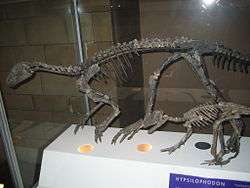Hypsilophodontia
| Hypsilophodontia Temporal range: Early Cretaceous–Late Cretaceous, 130–125 Ma | |
|---|---|
 | |
| Adult and juvenile skeletons of Hypsilophodon | |
| Scientific classification | |
| Kingdom: | Animalia |
| Phylum: | Chordata |
| Class: | Reptilia |
| Clade: | Dinosauria |
| Order: | †Ornithischia |
| Suborder: | †Ornithopoda |
| Clade: | †Hypsilophodontia Dollo, 1882 |
| Subgroups | |
Hypsilophodontia is a clade of small to large bodied ornithopods that lived during the Cretaceous that were found in North America, Eurasia and Australia. Traditionally the group has included almost all bipedal bird-hipped dinosaurs other than iguanodonts, and some phylogenetic analyses found it to be a natural group,[1][2][3] but most recent studies have found that the group is mostly paraphyletic and the taxa within represent a series leading up to Iguanodontia.[4][5][6][7][8][9][10][11]
References
- ↑ Sues, Hans-Dieter; Norman, David B. (1990). "Hypsilophodontidae, Tenontosaurus, Dryosauridae". In Weishampel, David B.; Dodson, Peter; Osmólska Halszka (eds.). The Dinosauria (1st ed.). Berkeley: University of California Press. pp. 498–509. ISBN 0-520-06727-4.
- ↑ Weishampel, David B.; Heinrich, Ronald E. (1992). "Systematics of Hypsilophodontidae and Basal Iguanodontia (Dinosauria: Ornithopoda)" (PDF). Historical Biology. 6 (3): 159–184. doi:10.1080/10292389209380426. Retrieved 2007-03-10.
- ↑ Gasulla, José Miguel; Escaso, Fernando; Narváez, Iván; Ortega, Francisco; Sanz, José Luis (2015). "A New Sail-Backed Styracosternan (Dinosauria: Ornithopoda) from the Early Cretaceous of Morella, Spain". PLoS ONE. 10 (12): e0144167. doi:10.1371/journal.pone.0144167. PMC 4691198
 . PMID 26673161.
. PMID 26673161. - ↑ Scheetz, Rodney D. (1998). "Phylogeny of basal ornithopod dinosaurs and the dissolution of the Hypsilophodontidae". Journal of Vertebrate Paleontology. 18 (3, Suppl.): 75A. doi:10.1080/02724634.1998.10011116.
- ↑ Winkler, Dale A.; Murry, Phillip A.; Jacobs, Louis L. (1998). "The new ornithopod dinosaur from Proctor Lake, Texas, and the deconstruction of the family Hypsilophodontidae". Journal of Vertebrate Paleontology. 18 (3, Suppl.): 87A. doi:10.1080/02724634.1998.10011116.
- ↑ Buchholz, Peter W. (2002). "Phylogeny and biogeography of basal Ornithischia". The Mesozoic in Wyoming, Tate 2002. Casper, Wyoming: The Geological Museum, Casper College. pp. 18–34.
- ↑ Weishampel, David B.; Jianu, Coralia-Maria; Csiki, Z.; Norman, David B. (2003). "Osteology and phylogeny of Zalmoxes (n.g.), an unusual euornithopod dinosaur from the latest Cretaceous of Romania". Journal of Systematic Palaeontology. 1 (2): 1–56. doi:10.1017/S1477201903001032.
- ↑ Norman, David B.; Sues, Hans-Dieter; Witmer, Larry M.; Coria, Rodolfo A. (2004). "Basal Ornithopoda". In Weishampel, David B.; Dodson, Peter; Osmólska Halszka (eds.). The Dinosauria (2nd ed.). Berkeley: University of California Press. pp. 393–412. ISBN 0-520-24209-2.
- ↑ Varricchio, David J.; Martin, Anthony J.; Katsura, Yoshihiro (2007). "First trace and body fossil evidence of a burrowing, denning dinosaur" (PDF). Proceedings of the Royal Society B: Biological Sciences. 274 (1616): 1361–1368. doi:10.1098/rspb.2006.0443. PMC 2176205
 . PMID 17374596. Retrieved 2007-03-22.
. PMID 17374596. Retrieved 2007-03-22. - ↑ Boyd, Clint A.; Brown, Caleb M.; Scheetz, Rodney D.; Clarke, Julia A. (2009). "Taxonomic revision of the basal neornithischian taxa Thescelosaurus and Bugenasaura". Journal of Vertebrate Paleontology. 29 (3): 758–770. doi:10.1671/039.029.0328.
- ↑ Boyd, Clint A. (2015). "The systematic relationships and biogeographic history of ornithischian dinosaurs". PeerJ. 3 (e1523). doi:10.7717/peerj.1523. PMC 4690359
 . PMID 26713260. Retrieved 5 January 2016.
. PMID 26713260. Retrieved 5 January 2016.
This article is issued from Wikipedia - version of the 8/1/2016. The text is available under the Creative Commons Attribution/Share Alike but additional terms may apply for the media files.